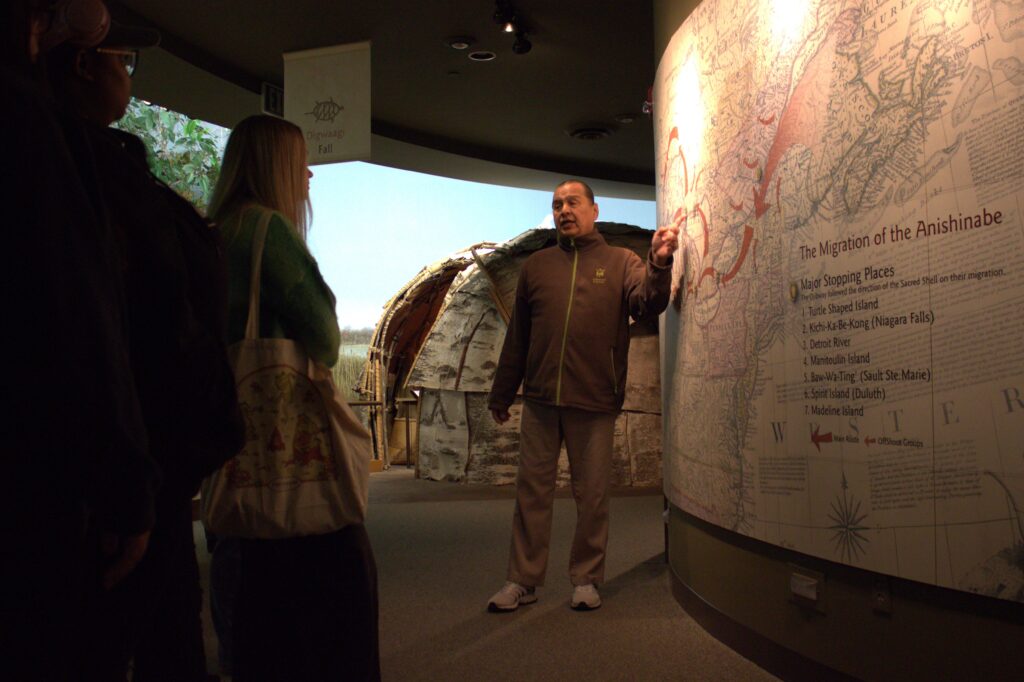Students and faculty traveled to the Ziibiwing Center of Anishinabe Culture and Lifeways in Mt. Pleasant to learn more about Native American culture.
Attendees were offered insight into the Anishinabek way of life through a tour of the museum’s permanent exhibit, Diba Jimooyung, which means “Telling Our Story.” The experience was further enriched with the opportunity to savor traditional foods, providing a deeper connection to the culture.

This trip, presented by Ferris’ Shoah Committee and the Office of Multicultural Student Services, was free to participants, covering transportation, admission and traditional Anishinabe cuisine.
Throughout the exhibit, viewers saw the Anishinabe way of life, learning how they believed in equality and that all walks of life shared the Earth.
Participants saw how the Anishinabe’s ways of life transformed into genocide as the colonization began through broken treaties, forced relocation and the boarding school system, which aimed to erase their culture.
Shoah Committee director and history professor Dr. Tracy Busch, who has been instrumental in organizing such impactful educational trips, emphasized the emotional and personal connections participants made during the visit.
As the director of the Shoah Committee, Busch works to foster understanding and awareness of historical tragedies, including those that involve Native American communities.
“I think it was a very emotionally meaningful trip,” Busch said. “People didn’t just read it in a book, but they were able to feel it and they’ve heard a lot of stories.”
The Shoah Committee is a group that is committed to preserving history’s memories and legacies to help people understand genocide, how it works and to prevent it from happening in the future.
Social work junior Jeneiah Canales, who participated in the trip, reflected on how much she learned about the Anishinabe culture, particularly how the community navigated life through astronomy.
“One thing that stood out to me in the exhibit was learning how, prior to colonization, this culture navigated life through the stars, moon and sun,” Canales said. “The back of a turtle shell was used as a navigational tool, with 13 squares representing their 13-month calendar and 28 surrounding squares symbolizing the 28 days of each moon phase.”
Canales sees the trips as vital in her personal growth and future career. With a passion for cultural awareness, Canales plans to take what she learned and share it with her sisters in Gamma Phi Omega, as well as with others in the various organizations she’s a part of, spreading her newfound knowledge and fostering cultural understanding within her community.
“This is very important for me and my major because it shows competence and the importance of being open to learning about different cultures,” Canales said. “I believe if I encounter anyone who’s Native American, I’ll have some knowledge about their culture.”
While the Shoah Committee’s archive is a vital resource for understanding the horrors of genocide, Busch noted that it does not include the stories of Native American genocide, which she believes is an essential piece of history often overlooked. She hopes to make this trip an annual event with an even wider variety of student majors attending.
“Those are the stories we do not have. They do not talk about Native American genocide in the Shoah archive,” Busch said. “Native American culture… I mean, it’s kind of tragic but that’s the original American culture. And we know so little about it. I think going to the Ziibiwing Center was a really important addition to the work that we do with the other testimonies.”
The trip underscored the importance of understanding Native American history and culture, encouraging continued learning and sharing to promote awareness and cultural appreciation.
The Shoah Committee will be posting a sign-up sheet for another outing to the Zekelman Holocaust Center and the Arab American National Museum, which is planned for Friday, April 11.
